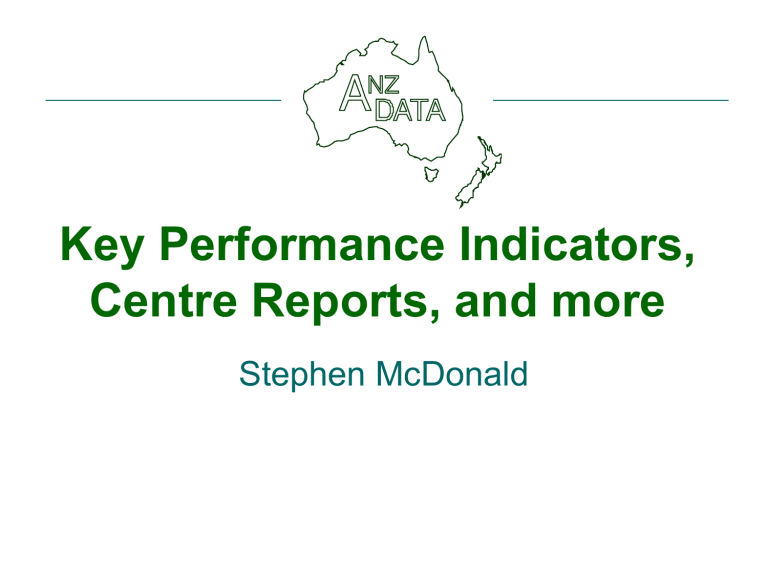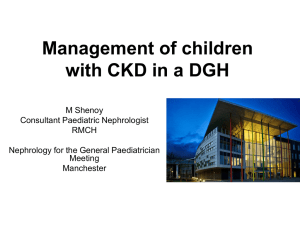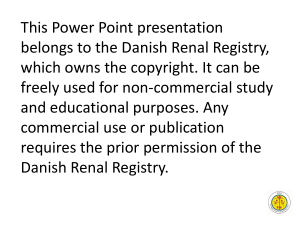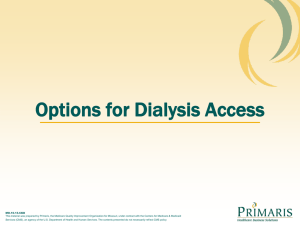Key Performance Indicators, Centre Reports, and more

Key Performance Indicators,
Centre Reports, and more
Stephen McDonald
Barbecue talk
120
100
80
60
40
20
1970 1980 1990
Year
Rate
Incident rate
95% CI
2000
Incident RRT, Australia only
2010
More “good” news
20
15
10
5
0-24
Age-specific incident RRT rates
Australia
25-34
70
60
50
40
30
200
150
100
50
65-74 75-84
600 300
45-54
85+
500
0
1980 1990 2000 2010
400
200
200
100
0
1980 1990 2000 2010
Year
Rate 95% CI
0
1980 1990 2000 2010
Graphs by age group
Indigenous incidence rates
Aboriginal & TSI, Australia
500
400
300
200
100
0
1985 1990 1995
Year
2000
Rate 95% CI
2005 2010
Background
• A number of ongoing work themes exist within ANZDATA for generating output
– Stock and flow figures
– Annual Report
– Contributor requests
• Responses to information needed for various projects
– Research projects (internal and external analyses)
– Outcomes reporting
Outcomes reporting
• Recent years have seen a growth of interest in outcomes reporting
• Centre reports have been part of
ANZDATA for many years, with increasing emphasis in recent years
– At “parent hospital level”
– Limited distribution historically
4
Why measure outcomes?
2
1
.5
.2
0 20 40 units
60
O/E 98% CI
All Australia & NZ Dialysis Units, 98% confidence intervals
80
Dialysis outcome
4
2
1
.5
.2
0 20 40
Units, ranked by RR
60
RR 95% CI
Mortality rate during dialysis treatment in Australia 2006-10, adjusted for demographics and comorbidities
80
50
.5
.25
2
1
20
10
5
Variation in transplant outcomes
0 5 10
Units
15
RR 95% CI
Fully adjusted 1 year graft survival, by unit
All transplant units, Australia and New Zealand, patients transplanted
2005-2019, followup to 2010
20
What is happening to centre reports?
• Greater reporting of demographics and comorbidities
• Adjusted analyses in transplanting centre and dialysis reports
– Details of models supplied
• Graphs
– Funnel plots
– CUSUM plots (transplant)
Centre reports – graph 1
Survival from 90th Day of Treatment
1.00
0.75
0.50
0.25
0.00
0
CNAR
Australia
New Zealand
1 2
Years
3 4 5
Centre reports – graph 2
Technique Survival - PD at 90 days
1.00
0.75
0.50
0.25
0.00
0
CNAR
Australia
New Zealand
1 2
Years
3 4 5
100
80
60
40
20
0
Everywhere else
But....
CNARTS
1.3
1.2
1.1
1
.9
.8
.7
CNAR
Adjusted graphs
Adjusted SMR (95% CI)
Australia New Zealand
Adjusted graphs
2.5
2
1.5
1
.5
0
0
CNAR
50 100 150
Expected Number of Deaths
200
How are reports derived?
You need a model
• Logistic regression model (transplant),
Poisson model (dialysis)
• Adjusted for demographics, comorbidities
(donor and XM variables)
• With this model, derive a probability of
“expected” failure for each person / graft based on covariate matrix
• Compare this with actual outcomes www.anzdata.org.au
Which predictors are important?
0,7
0,6
0,5
0,4
0,3
0,2
0,1
Harrell's C
Somer's D
0
Recipient age gender & graft number
+comorbidities + HLA matching
+ ischaemic time
+ donor age + cause donor death
Predictive power of multivariate Cox model predicting graft survival, all DD transplants 2001-2009, with sequential addition of covariate groups
Don’t adjust for…
• Factors within the control of centre
– These may be why a particular centre gets good or bad results
• Factors that occur as a result of treatment decisions
• For example, don’t adjust for
– Choice of dialysis modality, HD access
– Use of immunosuppressives, rejection, 1 month graft function… www.anzdata.org.au
Other graphical demonstrations of output
• Funnel plots are a static measure and summarise performance (relative to a comparator) over a fixed period of time.
– Lack a dynamic element
– Weight recent and distant results equally
Adding time – CUSUM
2
0
-2
-4
4
Twoway CUSUM for a transplant centre
400
300
200
100
0
Tx date
4
3
2
1
0
5
Removing credit for good deeds
Oneway CUSUM for for a hospital
Tx number
Do we need to do more?
Why KPIs?
• Mortality is an insensitive and late indicators of problems
– Hopefully rare
– Outcome of complex series of events
• Incompletely ascertained
– Important to monitor as best we can
• Key Process indicators
– Simpler to understand, easier to address
– Need to be valid and correctable (and related to meaningful outcomes)
KPI Project
• Dialysis KPI project commenced 2011
– At instigation of DNT committee
• 2 markers chosen – Peritonitis and HD access at first treatment
– Deliberately limited to existing data collection
• NO additional data collected
– Based on real time ANZDATA data collection
Variation in HD access
1
.8
.6
8
5 5
31
40
65
18 28
10
5
7
17
25
22
113
36
68
8
10
15
7
47
19
12
29
52
75
434452
29
11
34344144
12
44
64
20
10
17
314433
1923
13
9
28
15
54
6 8
66
.4
.2
0
0 20
Centres
Proportion
ANZDATA, access at first HD where first dialysis
40
95% CI
60
27
1.5
1
.5
2.5
2
3
Variation in peritonitis rate
Peritonitis rates by treating unit
2009 only
4
6
12
24
Confidence intervals not shown where upper limit >3
Units with <5 person-years PD over 2009 not shown
KPI reporting -- access
• Quarterly identified feedback to units
Peritonitis reporting
Where to from here?
• COMMUNICATE
• Improve data collection
• Improve access to results
• Enhance reporting
– Add peritonitis rates
– Access subdivided by late referral
– Graphs etc etc
• Or is it all just too hard?
How do we view quality?
Centre reports -- SMR











